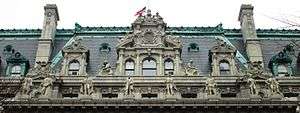Surrogate's Courthouse
|
Surrogate's Court | |
|
(2012) | |
| Location |
31 Chambers Street Manhattan, New York City |
|---|---|
| Coordinates | 40°42′48.64″N 74°0′16.52″W / 40.7135111°N 74.0045889°WCoordinates: 40°42′48.64″N 74°0′16.52″W / 40.7135111°N 74.0045889°W |
| Built | 1899-1907 |
| Architect | John R. Thomas; Horgan & Slattery |
| Architectural style | Beaux Arts |
| NRHP Reference # | 72000888 |
| Significant dates | |
| Added to NRHP | January 29, 1972[1] |
| Designated NHL | December 22, 1977[2] |
| Designated NYCL | February 15, 1966 |



The Surrogate's Courthouse, also known as the Hall of Records, is a Beaux Arts municipal building in lower Manhattan in New York City.
Opened in 1907, it is located on the northwest corner of Chambers and Centre Streets, across the street from City Hall Park and from the Municipal Building. It houses the city's Municipal Archives, as well as providing courtrooms for the Surrogate's Court for New York County on the fifth floor.
Architecture
The well-proportioned seven-story, steel-framed building is faced with granite from Hallowell, Maine, and contains elaborate marble interiors. The three-part Chambers Street facade features a triple-arched main entrance centered along the two-story base, above which is centered a three-story Corinthian colonnade topped by a cornice, a sixth story, another cornice and a mansard roof.[3]
It was designed to be fireproof, in order to safely house the city's paper records. The Beaux Arts exterior features fifty-four sculptures by prize-winning artists Philip Martiny and Henry Kirke Bush-Brown, representing both allegorical figures — such as New York in Its Infancy, New York in Revolutionary Times, Philosophy, Law, and the seasons — and eminent figures from the city's past, including Peter Stuyvesant, DeWitt Clinton, David Pietersen De Vries, and mayors Caleb Heathcote, Abram Stevens Hewitt, Philip Hone, Cadwallader David Colden and James Duane.[4][5]
There is a three-story interior courtyard, supposedly inspired by the Paris Opera, featuring an imposing marble double staircase leading to colonnaded balconies on the upper stories. It's considered one of the city's finest Beaux Arts interiors.[3] Mosaic murals showing the zodiac were created by William DeLeftwich Dodge. The elaborate Surrogates' courtrooms on the fifth floor are endowed with carved oak and mahogany paneling, and gilded plaster decoration.[4]
The building has been favorably compared to the somewhat smaller Chamber of Commerce building and the somewhat larger Customs House, both contemporaries of this building in lower Manhattan.[3]
A rear entrance to the building has been made accessible to people with disabilities, although some claim some internal obstacles remain.[6]
History
A new Hall of Records, to replace a badly outdated building in City Hall Park, had been planned since 1888. The building was designed by John R. Thomas and built between 1899 and 1907. Thomas was credited with being the nation's most prolific designer of public and semi-public buildings.[4] He based his design on his award-winning plan for a new City Hall that was never constructed. Horgan & Slattery, an architectural firm with Tammany Hall connections, completed the project after Thomas's death. The total cost was more than seven million dollars.[7]
Although the fifth-floor Surrogates' courtrooms were planned as part of the building from the beginning, the name Hall of Records was not officially changed to Surrogate's Courthouse until 1962.[7]
The building has suffered from few alterations over the years,[4] aside from the removal of some Martiny statues facing Centre Street when that street was widened in 1961.[7] Those statues, Authority and Justice, are nearby at the New York County Courthouse, 60 Centre Street.[5]
The interior is popular with film and television production companies and has been used in dozens of commercials, series and movies.[4] Both the exterior (1966) and interior (1976) are New York City Landmarks,[8] and the building is on the National Register of Historic Places (1972).[4] It was designated a National Historic Landmark in 1977.[2]
See also
- List of New York City Landmarks
- National Register of Historic Places listings in New York County, New York
References
Notes
- ↑ National Park Service (2007-01-23). "National Register Information System". National Register of Historic Places. National Park Service.
- 1 2 "Surrogate's Court". National Historic Landmark summary listing. National Park Service. 2007-09-19.
- 1 2 3 Paul Goldberger, The City Observed: New York: A Guide to the Architecture of Manhattan. New York: Vintage Books, 1979, p. 31. ISBN 0-394-72916-1
- 1 2 3 4 5 6 New York State Unified Court System, Surrogate's Court, Historical Information. Accessed April 1, 2011
- 1 2 NYC - Civic Center, djibnet.com. Accessed April 1, 2011
- ↑ Questionnaire, 504 Democratic Club. Accessed April 1, 2011
- 1 2 3 DCAS Managed Public Buildings, The Surrogate's Courthouse. Accessed April 1, 2011
- ↑ New York City Landmarks Preservation Commission; Dolkart, Andrew S. (text); Postal, Matthew A. (text) (2009), Postal, Matthew A., ed., Guide to New York City Landmarks (4th ed.), New York: John Wiley & Sons, ISBN 978-0-470-28963-1 pp.31-32
External links
 Media related to Surrogate's Courthouse (Manhattan) at Wikimedia Commons
Media related to Surrogate's Courthouse (Manhattan) at Wikimedia Commons- Exterior sculptures on Surrogates Courthouse

